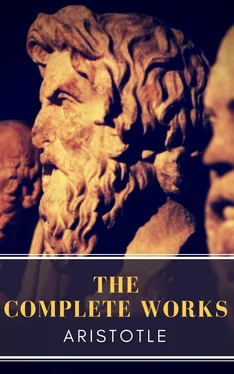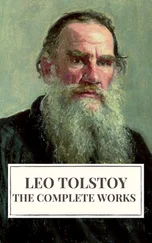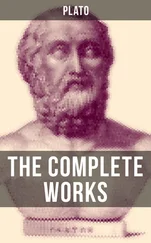Aristotle Aristotle - Aristotle - The Complete Works
Здесь есть возможность читать онлайн «Aristotle Aristotle - Aristotle - The Complete Works» — ознакомительный отрывок электронной книги совершенно бесплатно, а после прочтения отрывка купить полную версию. В некоторых случаях можно слушать аудио, скачать через торрент в формате fb2 и присутствует краткое содержание. Жанр: unrecognised, на английском языке. Описание произведения, (предисловие) а так же отзывы посетителей доступны на портале библиотеки ЛибКат.
- Название:Aristotle: The Complete Works
- Автор:
- Жанр:
- Год:неизвестен
- ISBN:нет данных
- Рейтинг книги:3 / 5. Голосов: 1
-
Избранное:Добавить в избранное
- Отзывы:
-
Ваша оценка:
- 60
- 1
- 2
- 3
- 4
- 5
Aristotle: The Complete Works: краткое содержание, описание и аннотация
Предлагаем к чтению аннотацию, описание, краткое содержание или предисловие (зависит от того, что написал сам автор книги «Aristotle: The Complete Works»). Если вы не нашли необходимую информацию о книге — напишите в комментариях, мы постараемся отыскать её.
This edition has been professionally formatted and contains several tables of contents. The first table of contents (at the very beginning of the ebook) lists the titles of all novels included in this volume. By clicking on one of those titles you will be redirected to the beginning of that work, where you'll find a new TOC that lists all the chapters and sub-chapters of that specific work.
Aristotle: The Complete Works — читать онлайн ознакомительный отрывок
Ниже представлен текст книги, разбитый по страницам. Система сохранения места последней прочитанной страницы, позволяет с удобством читать онлайн бесплатно книгу «Aristotle: The Complete Works», без необходимости каждый раз заново искать на чём Вы остановились. Поставьте закладку, и сможете в любой момент перейти на страницу, на которой закончили чтение.
Интервал:
Закладка:
Now induction, or rather the syllogism which springs out of induction, consists in establishing syllogistically a relation between one extreme and the middle by means of the other extreme, e.g. if B is the middle term between A and C, it consists in proving through C that A belongs to B. For this is the manner in which we make inductions. For example let A stand for long-lived, B for bileless, and C for the particular long-lived animals, e.g. man, horse, mule. A then belongs to the whole of C: for whatever is bileless is long-lived. But B also (’not possessing bile’) belongs to all C. If then C is convertible with B, and the middle term is not wider in extension, it is necessary that A should belong to B. For it has already been proved that if two things belong to the same thing, and the extreme is convertible with one of them, then the other predicate will belong to the predicate that is converted. But we must apprehend C as made up of all the particulars. For induction proceeds through an enumeration of all the cases.
Such is the syllogism which establishes the first and immediate premiss: for where there is a middle term the syllogism proceeds through the middle term; when there is no middle term, through induction. And in a way induction is opposed to syllogism: for the latter proves the major term to belong to the third term by means of the middle, the former proves the major to belong to the middle by means of the third. In the order of nature, syllogism through the middle term is prior and better known, but syllogism through induction is clearer to us.
24
We have an ‘example’ when the major term is proved to belong to the middle by means of a term which resembles the third. It ought to be known both that the middle belongs to the third term, and that the first belongs to that which resembles the third. For example let A be evil, B making war against neighbours, C Athenians against Thebans, D Thebans against Phocians. If then we wish to prove that to fight with the Thebans is an evil, we must assume that to fight against neighbours is an evil. Evidence of this is obtained from similar cases, e.g. that the war against the Phocians was an evil to the Thebans. Since then to fight against neighbours is an evil, and to fight against the Thebans is to fight against neighbours, it is clear that to fight against the Thebans is an evil. Now it is clear that B belongs to C and to D (for both are cases of making war upon one’s neighbours) and that A belongs to D (for the war against the Phocians did not turn out well for the Thebans): but that A belongs to B will be proved through D. Similarly if the belief in the relation of the middle term to the extreme should be produced by several similar cases. Clearly then to argue by example is neither like reasoning from part to whole, nor like reasoning from whole to part, but rather reasoning from part to part, when both particulars are subordinate to the same term, and one of them is known. It differs from induction, because induction starting from all the particular cases proves (as we saw) that the major term belongs to the middle, and does not apply the syllogistic conclusion to the minor term, whereas argument by example does make this application and does not draw its proof from all the particular cases.
25
By reduction we mean an argument in which the first term clearly belongs to the middle, but the relation of the middle to the last term is uncertain though equally or more probable than the conclusion; or again an argument in which the terms intermediate between the last term and the middle are few. For in any of these cases it turns out that we approach more nearly to knowledge. For example let A stand for what can be taught, B for knowledge, C for justice. Now it is clear that knowledge can be taught: but it is uncertain whether virtue is knowledge. If now the statement BC is equally or more probable than AC, we have a reduction: for we are nearer to knowledge, since we have taken a new term, being so far without knowledge that A belongs to C. Or again suppose that the terms intermediate between B and C are few: for thus too we are nearer knowledge. For example let D stand for squaring, E for rectilinear figure, F for circle. If there were only one term intermediate between E and F (viz. that the circle is made equal to a rectilinear figure by the help of lunules), we should be near to knowledge. But when BC is not more probable than AC, and the intermediate terms are not few, I do not call this reduction: nor again when the statement BC is immediate: for such a statement is knowledge.
26
An objection is a premiss contrary to a premiss. It differs from a premiss, because it may be particular, but a premiss either cannot be particular at all or not in universal syllogisms. An objection is brought in two ways and through two figures; in two ways because every objection is either universal or particular, by two figures because objections are brought in opposition to the premiss, and opposites can be proved only in the first and third figures. If a man maintains a universal affirmative, we reply with a universal or a particular negative; the former is proved from the first figure, the latter from the third. For example let stand for there being a single science, B for contraries. If a man premises that contraries are subjects of a single science, the objection may be either that opposites are never subjects of a single science, and contraries are opposites, so that we get the first figure, or that the knowable and the unknowable are not subjects of a single science: this proof is in the third figure: for it is true of C (the knowable and the unknowable) that they are contraries, and it is false that they are the subjects of a single science.
Similarly if the premiss objected to is negative. For if a man maintains that contraries are not subjects of a single science, we reply either that all opposites or that certain contraries, e.g. what is healthy and what is sickly, are subjects of the same science: the former argument issues from the first, the latter from the third figure.
In general if a man urges a universal objection he must frame his contradiction with reference to the universal of the terms taken by his opponent, e.g. if a man maintains that contraries are not subjects of the same science, his opponent must reply that there is a single science of all opposites. Thus we must have the first figure: for the term which embraces the original subject becomes the middle term.
If the objection is particular, the objector must frame his contradiction with reference to a term relatively to which the subject of his opponent’s premiss is universal, e.g. he will point out that the knowable and the unknowable are not subjects of the same science: ‘contraries’ is universal relatively to these. And we have the third figure: for the particular term assumed is middle, e.g. the knowable and the unknowable. Premisses from which it is possible to draw the contrary conclusion are what we start from when we try to make objections. Consequently we bring objections in these figures only: for in them only are opposite syllogisms possible, since the second figure cannot produce an affirmative conclusion.
Besides, an objection in the middle figure would require a fuller argument, e.g. if it should not be granted that A belongs to B, because C does not follow B. This can be made clear only by other premisses. But an objection ought not to turn off into other things, but have its new premiss quite clear immediately. For this reason also this is the only figure from which proof by signs cannot be obtained.
We must consider later the other kinds of objection, namely the objection from contraries, from similars, and from common opinion, and inquire whether a particular objection cannot be elicited from the first figure or a negative objection from the second.
Читать дальшеИнтервал:
Закладка:
Похожие книги на «Aristotle: The Complete Works»
Представляем Вашему вниманию похожие книги на «Aristotle: The Complete Works» списком для выбора. Мы отобрали схожую по названию и смыслу литературу в надежде предоставить читателям больше вариантов отыскать новые, интересные, ещё непрочитанные произведения.
Обсуждение, отзывы о книге «Aristotle: The Complete Works» и просто собственные мнения читателей. Оставьте ваши комментарии, напишите, что Вы думаете о произведении, его смысле или главных героях. Укажите что конкретно понравилось, а что нет, и почему Вы так считаете.












